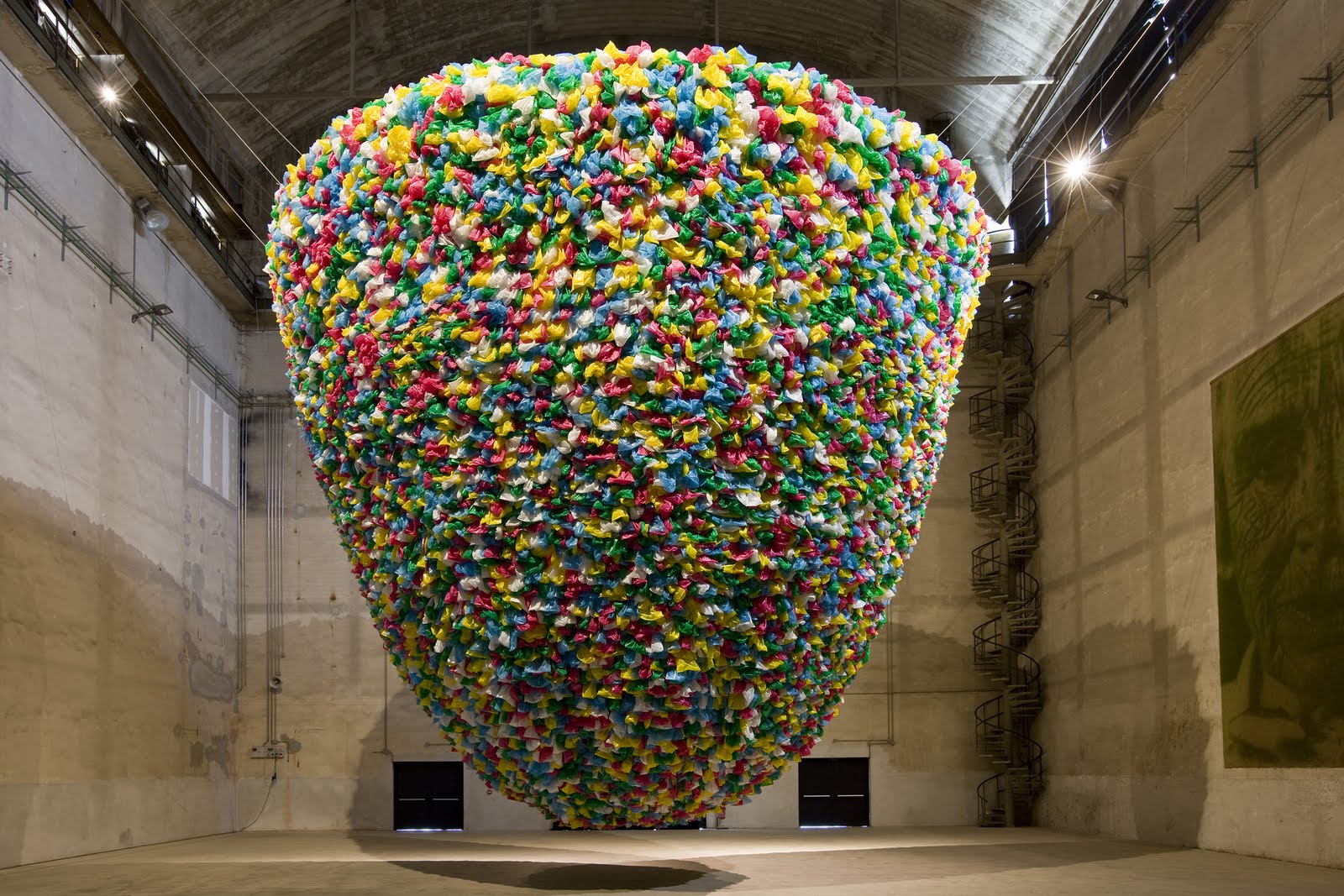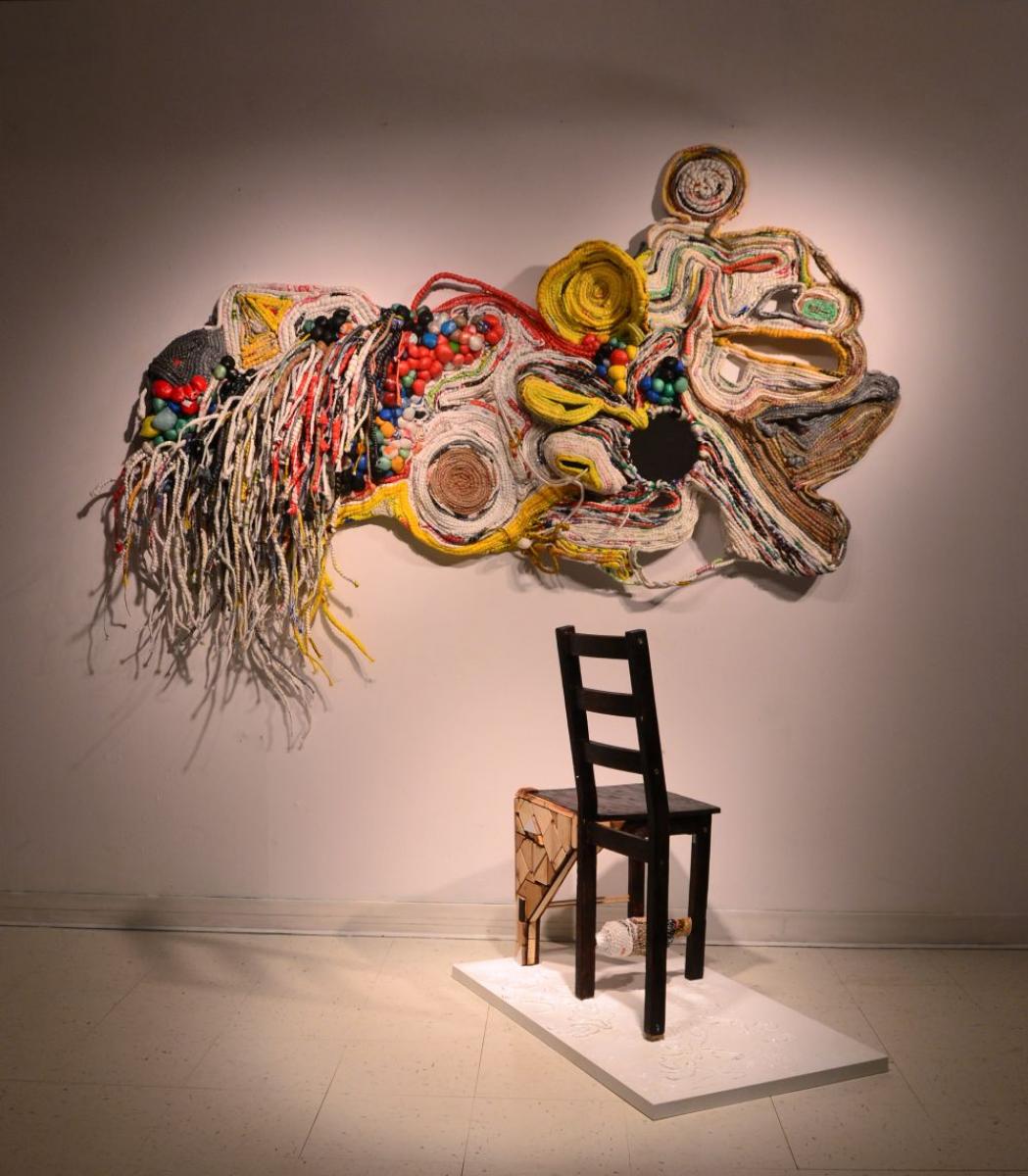While participants in the the Afri Plastics Challenge address the problems of plastics in Sub-Saharan Africa through innovation a growing number of respected African artists are also raising awareness and promoting behavioural change regarding plastic waste.
Prompting viewers to think about things in new ways is one of the historic roles of art and artists have often addressed the “big issues” of the times in which they live. So, in an era of unprecedented environmental crisis in Africa, it is no surprise that the continent’s artists are increasingly turning their attention to environmental issues.
One of the notable features in the work of contemporary African artists using waste plastic as a material is a cultural perspective in which plastics do not have the same connotations or “meanings” as they do in numerous other regions of the world. In wealthy, technologically advanced countries, plastic has long been viewed as a cheap, disposable material, one of the very reasons for today’s pressing ecological problems. Plastic, though non-biodegradable, was discarded without thought for decades.
But in many African countries, particularly in poorer regions or places with a less developed infrastructure, what is considered throwaway elsewhere might be highly valued. A plastic bag or bottle readily relegated to the litter bin in affluent regions might be a useful and repeatedly re-used receptacle for carrying goods or water over great distances.
Plastic and Africa
In the work of numerous contemporary African artists, plastic is deployed as a “poor material”—in the tradition of Arte Povera—that is far more ambiguous. As with the influential Italian Arte Povera movement of the 1960s, sometimes plastic, a “poor material”, has a political dimension, evoking the continent’s colonial history and repeated exploitation. Africa’s extremely rich materials—gold, diamonds, copper, manganese or precious woods—have repeatedly been exploited by arrivistes and colonisers while its peoples are “rewarded” with supposedly desirable First World technological advancements; plastic, for example.
Simultaneously, some artists look to the traditions of African cultures that rely on available resources, sometimes in unforgiving biomes or social conditions, with resilient ingenuity and pragmatism. Just as African people once looked to natural materials—clay, barks, grasses or even ostrich eggs—to create everything from clothing and shelter, to receptacles for carrying water across arid deserts, so too have modern Africans embraced the detritus of industrialisation as useful materials. Think of comfortable sandals made from worn-out tires sold in the markets in Zimbabwe or children playing with intricate toys created from discarded tin cans in Ghana: there is an argument to say that recycling was invented through necessity in Africa long before the rest of the world understood it as essential.
In African contemporary art, plastic evokes many things, from the continent’s history of finding something rich in a poor material, to political statements; from the aesthetic, to calls to action to reduce the damage to the continent and its surrounding seas and oceans. In the work of the four artists detailed below, you’ll find some or all of these themes.
Pascale Marthine Tayou
Born in Cameroon, Pascale Marthine Tayou is one of Africa’s preeminent contemporary artists whose work has been shown around the world in prestigious institutions. He first rose to prominence through his involvement in Doual’art, the Cameroonian arts NGO focussed on African urbanism.
Much of his work involves reusing and recycling disposable materials from his travels; anything from train tickets to plastic razors. One dominant theme in his art is the notion of “recycling the banal”. Works that utilise waste plastic are not only a statement on the plastic pollution of Africa, but simultaneously address themes of economics, migration and politics. Much of his work in the 1990s concerned itself with socioeconomic realities of HIV/AIDS in Africa. But, in more recent years, his works, such as large-scale installations made from plastic waste, draw attention to Africa’s environmental crisis. These works offer not only the more familiar story in which Africans are the victims of exploitation but simultaneously another, in which Pascale Marthine Tayou seems to be exhorting new generations of urban Africans to consider their own decisions regarding the environmental future.
Pascale Marthine Tayou, 'Plastic Bags' (2001-2011). 'Terre vulnerabili', exhibition view at Hangar Bicocca, 2011. Courtesy of the artist and Galleria Continua. Photo by Agostino Osio, © ADAGP, Paris

Ifeoma U. Anyaeji
Ifeoma U. Anyaeji is a Nigerian artist born in Benin City, where she started her education as an artist, training as a painter, before completing her studies abroad. Describing herself as a “neo-traditional” artist, she creates everything from conceptual sculpture to artist-made accessories, clothing and furniture.
Her use of waste plastic relates back to the African tradition of recycling, of making “poor materials”—discarded plastic bags—”rich”, by treating them as “high art” materials and giving them a new lease on life as part of a work of art. But, there is also another discourse running through her practice, a feminist perspective important to many African women artists who experience all of the same systemic barriers as women artists all over the world, but also endure other more specific forms of sexism and traditional prejudice.
For example, Anyaeji’s sculptures often use waste plastic as if it were hair, which draws on the distinctive (Diasporan) African tradition of “threading”, a tradition of hair braiding. She prompts a discussion that both foregrounds the material culture of African women and girls as well as embracing complex sociopolitical and environmental issues.
Ifeoma U. Anyaeji, ‘Ezuhu ezu - In(complete)’. Exhibition view (2019). Baltic Centre for Contemporary Art

Fabrice Monteiro
Born in Belgium, Fabrice Monteiro grew up in Benin and currently lives in Dakar. He studied engineering before becoming a professional model, a career that facilitated his later move to the other side of the lens. As a photographer, Monteiro’s work shifts effortlessly from documentary to portraiture and high fashion. Much of his stylised portraiture covers themes such as African culture and traditions and, his documentary photography captures the lives of different communities and the environmental challenges they face.
Monteiro’s work has been concerned with environmental issues for quite some time, ever since he returned to Africa in 2012 after working in Europe for decades. He has spoken of his shock at the level of plastic and other pollution he encountered on his arrival in Senegal compared with the Africa of his youth. He decided to raise awareness using photography.
This is particularly striking in his staged almost narrative works such as in the series The Prophecy. In the images, elaborately costumed models are shown within the polluted landscapes of Senegal—such as the massive Mbeubeuss waste dump just north of Dakar. The photos have a dramatic, ominous air that, as the series’ title suggests, convey an impending ecological apocalypse with a visual language drawing on African mythology.
Mbongeni Buthelezi
Mbongeni Buthelezi was born in Kwazulu-Natal and trained as an artist in South Africa, where he still lives and works, showing frequently in galleries and museums across the country. He has undertaken numerous artist residencies around the world and his work has been exhibited internationally including in Germany, Canada, Australia, Portugal, Austria and The Netherlands.
Buthelezi has become known as the artist who “paints” in recycled plastic. At first glance, his works have the appearance of representational or figurative scenes executed in a painterly manner. But closer inspection reveals that he makes his works using strips of reclaimed waste plastic that he manipulates using heat.
The imagery in his paintings often draws on personal memories or observed scenes of everyday life, but his chosen materials also tell a story. Deeply conscious of plastic pollution, he and his assistants collect waste plastic to use in his work, literally clearing up litter and turning it into art. Buthelezi hopes to encourage others to find creative uses for recycled materials that can reduce pollution. And, of course, there is also a conceptual layer to the work, the materials reminding viewers of socioeconomic circumstances in which African artists work as well as a prompt to reconsider how resources could be used.
